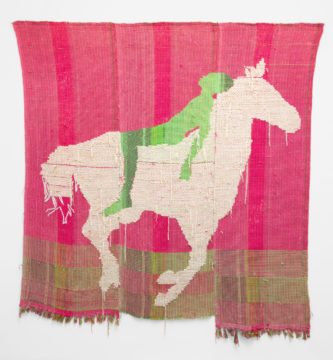Amber Officer-Narvasa in Guernica:
 when no softness came, we looked for the tired in each other’s knees. Held it up by our fingertips, wove a bed where we might dream. When no softness came, I cried in the shower and gave my anger to the sea. I forgot I wasn’t alone until the spirit with nine hundred and sixteen selves came and goaded me into staying alive. Reclining backward on a moving horse, the figure in your tapestry looks like they’re doing an impossible thing. I recognized it as I walked through the gallery — the taut and tender of seeking rest in a place swirling with its impossibility.
when no softness came, we looked for the tired in each other’s knees. Held it up by our fingertips, wove a bed where we might dream. When no softness came, I cried in the shower and gave my anger to the sea. I forgot I wasn’t alone until the spirit with nine hundred and sixteen selves came and goaded me into staying alive. Reclining backward on a moving horse, the figure in your tapestry looks like they’re doing an impossible thing. I recognized it as I walked through the gallery — the taut and tender of seeking rest in a place swirling with its impossibility.
The Black cowboys they show us in school, in movies and magazines, are upright, stoic. They look out at us defiantly from grayscale photographs, demanding we mark their presence in the expansionist and messy histories of the so-called American West. Growing up, I never thought to ask if Bass Reeves was sometimes tired after long days chasing horse thieves and wrangling cattle on Chickasaw land. If Stagecoach Mary ever just wanted to lie next to the woman she traveled over a thousand miles for and never deliver mail again. Diedrick, I guess what I’m trying to say is that the image of the horse — in visual art, in archives — sometimes seems irretrievably bound up with a mythos of masculinity and war, an imperative of action. That the back of a horse is so often the site of the most scripted discursive struggles over who we can be.
I’m thinking here of Kehinde Wiley’s painting of a Black Napoleon, a durag-clad man on a rearing horse, getting ready to lead invading armies across the Alps.
More here.(Note: At least one post throughout the month of February will be devoted to Black History Month. The theme for 2022 is Black Health and Wellness)
